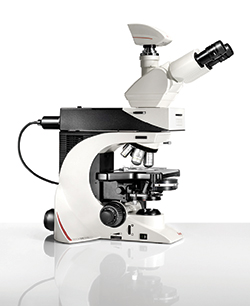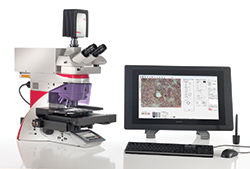 The Leica DM2500 LED is suitable for clinical laboratories and for research applications in microbiology, developmental biology, cytology, zoology, botany, and more. The ultra-bright LED illumination of the DM2500 LED offers a constant color temperature at all light intensities, enabling particularly fine differentiation of colors in stained specimens. The LED illumination is also suitable for unstained or low-contrast specimens and high magnifications, e.g. for light-intensive phase or differential interference contrast applications. Users benefit from the brightness and color accuracy of the LED illumination in all other transmitted light contrasting techniques, such as bright-field, polarized light, and dark-field. The ergonomic design comprises height-adjustable focus knobs and various ergo modules for customizing the microscope to the individual user.
The Leica DM2500 LED is suitable for clinical laboratories and for research applications in microbiology, developmental biology, cytology, zoology, botany, and more. The ultra-bright LED illumination of the DM2500 LED offers a constant color temperature at all light intensities, enabling particularly fine differentiation of colors in stained specimens. The LED illumination is also suitable for unstained or low-contrast specimens and high magnifications, e.g. for light-intensive phase or differential interference contrast applications. Users benefit from the brightness and color accuracy of the LED illumination in all other transmitted light contrasting techniques, such as bright-field, polarized light, and dark-field. The ergonomic design comprises height-adjustable focus knobs and various ergo modules for customizing the microscope to the individual user.
With the upright Leica DM4 B and Leica DM6 B microscopes for life science research and clinical applications, users can choose between halogen and LED illumination in the transmitted light path. The camera field of view of 19 mm is matched to the chip size of scientific CMOS cameras. The Leica Application Suite X imaging software guides users through image acquisition step by step. From a complete or dedicated slide overview, users can quickly navigate to a region of interest and zoom in to see details in a higher magnification with the Specimen Overview.
New from Leica’s microdissection microscope series are the LMD6 and the LMD7 with LED illumination for transmitted light. The laser microdissection systems enable dissection of a wide variety of biological samples. Specimens ranging from mammalian and human cells to plants and bacteria can be specifically isolated and collected for use in genomics (DNA), transcriptomics (mRNA, miRNA), proteomics, metabolomics, and next-generation sequencing.
 Users can now choose between halogen and LED illumination, and both systems collect samples by means of gravity, enabling the user to collect samples contact-free, regardless of the material’s size and shape, and ensuring that samples remain free of contamination. High-precision optics guide the movement of the laser beam while the sample remains fixed during laser dissection.
Users can now choose between halogen and LED illumination, and both systems collect samples by means of gravity, enabling the user to collect samples contact-free, regardless of the material’s size and shape, and ensuring that samples remain free of contamination. High-precision optics guide the movement of the laser beam while the sample remains fixed during laser dissection.
Leica Microsystems, 800-248-0123
 CAP TODAY Pathology/Laboratory Medicine/Laboratory Management
CAP TODAY Pathology/Laboratory Medicine/Laboratory Management
